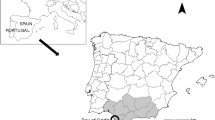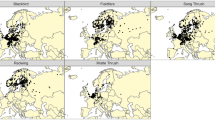Abstract
Based on the results of trap** and ringing long-eared owls on the Curonian Spit in Kaliningrad oblast in the amount of 3391 individuals during 1957–2016, the population numbers, the migration routes and wintering grounds, the age structure, and the causes of bird death were studied. The overall efficiency of ringing was 3.01%, but the number of ring recoveries decreased significantly over time. The annual number of long-eared owls captured varied widely over 60 years, from 1 to 365 individuals. The oscillations were wave-like in nature and showed different amplitudes. In this regard, we discuss the numbers of long-eared owls and the degree of their territorial mobility in relation to abundance variations in the voles as their main food objects. Among the migrating owls, immature individuals (83%) and females (65%) predominated, and the longevity record was 16 years and 3 months. Of all 102 ring recoveries, only 16 birds were found alive. The main direction of flights in autumn was from south to west. The largest number of ring recoveries indicating the main flyways and wintering grounds came from Germany and neighboring countries at latitudes of 50°–54°N. Some ring recoveries indicate the origins of the populations of long-eared owls migrating through the Curonian Spit, since subsequently they were found is Lithuania, Latvia, Belarus, Finland, as well as on different territories of Russia, from Leningrad oblast to Tatarstan.






Similar content being viewed by others
REFERENCES
Belopolsky, L.O., Characteristics of migrations of some owls (Strigiformes) according to the data of their capture and ringing on the Curonian Spit in 1957–1968, Soobshch. Pribalt. Kom. Izuch. Migr. Ptits, 1975, no. 8, pp. 51–71.
Björklund, H., Saurola, P., and Valkama, J., Breeding and population trends of common raptors and owls in Finland in 2015, Linnut-Vuosikirja. Vuosi, 2015, pp. 41–53.
Bolshakov, C.V., Shapoval, A.P., and Zelenova, N.P., Results of bird ringing by the Biological Station “Rybachy” on the Courish Spit in 1998, Avian Ecol. Behav., 1999, vol. 2, pp. 105–150.
Bolshakov, C.V., Shapoval, A.P., and Zelenova, N.P., Results of bird ringing by the Biological Station “Rybachy” on the Courish Spit: long-distance recoveries of birds ringed in 1956–1997. Part 1, Avian Ecol. Behav., 2001, suppl. 1, pp. 1–126.
Bolshakov, C.V., Shapoval, A.P., and Zelenova, N.P., Results of bird ringing by the Biological Station “Rybachy” on the Courish Spit in 2004, Avian Ecol. Behav., 2005, vol. 13, pp. 47–95.
Bolshakov, C.V., Shapoval, A.P., and Zelenova, N.P., Results of bird ringing by the Biological Station “Rybachy” on the Courish Spit in 2005, Avian Ecol. Behav., 2008, vol. 14, pp. 49–100.
Busse, P., European passerine migration system—what is known and what is lacking, Ring, 2001, vol. 23, nos. 1‒2, pp. 3–6.
Busse, P. and Busse, W., Autumn migration of owls along the Polish Baltic Sea coast 1961–1999, Vogelwelt, 2003, vol. 124, pp. 281–284.
Cramp, S., The Birds of the Western Palearctic, Oxford University Press, 1985, vol. 4.
Dement’ev, G.P., Order Strigiformes, in Ptitsy Sovetskogo Soyuza (Birds of the Soviet Union), Moscow: Nauka, 1951, pp. 342–429.
Demongin, L., Identification Guide to Birds in the Hand, Published by L. Demongin, 2016.
Dobrynina, I.N., Seasonal movements of owls (Strigiformes) in the Baltic region based on ringing data, Ring, 1994, vol. 16, nos. 1–2, pp. 77–83.
Dolnik, V.R. and Payevsky, V.A., Rybachy trap, in Kol’tsevanie v izuchenii migratsii ptits fauny SSSR (Banding in the Study of Bird Migrations of the Fauna of the USSR), Moscow: Nauka, 1976, pp. 73–81.
Eck, S. and Busse, H., Eulen. Die Neue Brehm-Bücherei, Wittenberg Lutherstadt: A. Ziemsen Verlag, 1973.
Graubits, G., New in catching owls during autumn migration in Pape, in Materialy IX Pribaltiiskoi ornitologicheskoi konferentsii (Proc. IX Baltic Ornithol. Conf.), Vilnius, 1976, pp. 76–80.
Hollender, M. and Woolf, D., Neparametricheskie metody statistiki (Nonparametric Statistics Methods), Moscow: Finansy i statistika, 1983.
Holt, D.W., Sex differences in long-eared owl plumage coloration, J. Raptor Res., 2016, vol. 50, no. 1, pp. 60–69.
Houston, C.S., Long-eared owls, Asio otus: a review of North American banding, Can. Field-Nat., 2005, vol. 119, no. 3, рр. 395‒402.
Ivanovskii, V.V., Reproduction of the long-eared owl Asio otus in the Vitebsk region during the period of high abundance of the species, Russ. Ornitol. Zh., 2015, vol. 24, no. 1217, pp. 4201–4206.
Khrabryi, V.M. and Baibekova, S.A., Winter breeding of the long-eared owl Asio otus in St. Petersburg, Russ. Ornitol. Zh., 2015, vol. 24, no. 1123, pp. 1057–1062.
Konstantinov, V.M., Margolin, V.A., and Babenko, V.G., Features of the ecology of the long-eared owl in the anthropogenic landscapes of the Central region of the European part of the USSR, in Gnezdovaya zhizn’ ptits (Nesting Life of Birds), Perm, 1982, pp. 121–132.
Korpimäki, E., Diet composition, prey choice, and breeding success of long-eared owl: effect of multiannual fluctuations in food abundance, Can. J. Zool., 1992, vol. 70, pp. 2373–2381.
Korpimäki, E., Rapid or delayed tracking of multiannual vole cycles by avian predators?, J. Anim. Ecol., 1994, vol. 63, pp. 619–628.
Korpimäki, E. and Norrdahl, K., Numerical and functional responses of kestrels, short-eared owls, and long-eared owls to vole densities, Ecology, 1991, vol. 72, pp. 814–826.
Michalonek D., Busse W., and Lasecki R., Age structure of the Long-eared Owl (Asio otus) migration at Bukowo-Kopañ station (southern Baltic coast) in autumns 1996–2003, Ring, 2005, vol. 27, no. 2, pp. 145–157.
Morozov, N.S. and Kontorshchikov, V.V., Winter clutches of long-eared owls in Moscow in 2008, Ornitologiya, 2008, vol. 35, pp. 137–142.
Noga, M., Winter breeding of the Long-eared Owl (Asio otus) in South-Western Slovakia, Slovak Raptor J., 2009, vol. 3, pp. 61–62.
Noskov, G.A. and Lapshin, N.V., The long-eared owl Asio otus, in Migratsii ptits Severo-Zapada Rossii. Nevorob’inye (Migrations of Birds of the North-West of Russia. Non-Passerines), Noskov, G.A., Rymkevich, T.A., and Gaginska, A.R., Eds., St. Petersburg: ANOLA Professional, 2016.
Payevsky, V.A., Atlas of bird migrations according to ringing data on the Curonian Spit, in Ekologicheskie i fiziologicheskie aspekty pereletov ptits (Ecological and Physiological Aspects of Bird Flights), Tr. Zool. Inst. Akad. Nauk SSSR, Leningrad, 1971, vol. 50, pp. 3–110.
Payevsky, V.A., Reliability of information about bird migration routes according to ringing data, Ekologiya, 1973, no. 2, pp. 98–100.
Payevsky, V.A., Demografiya ptits (Bird Demography), Leningrad: Nauka, 1985.
Payevsky, V.A., The speed of migratory movements of birds as an adaptive behavior, Zh. Obshch. Biol., 2012, vol. 73, no. 5, pp. 360–375.
Payevsky, V.A. and Shapoval, A.P., Banding efficiency of birds depending on their species, sex, age, season, and place of ringing, Ornitologiya, 1998, vol. 28, pp. 212–218.
Payevsky, V.A. and Shapoval, A.P., The decrease in the rate of ring returns from banded birds over the past 50 years: what are the reasons for this phenomenon?, Ornitologiya, 2013, vol. 38, pp. 24–31.
Priklonskii, S.G. and Ivanchev, V.P., The long-eared owl, in Ptitsy Rossii i sopredel’nykh regionov: Ryabkoobraznye, Golubeobraznye. Kukushkoobraznye, Sovoobraznye (Birds of Russia and Adjacent Regions: Pterocliformes, Columbiformes, Cuculiformes, and Strigiformes), Moscow: Nauka, 1993, pp. 302–313.
Pukinskii, Yu.B., Life of owls, in Zhizn’ nashikh ptits i zverei (Life of Our Birds and Animals), Leningrad: Leningr. Univ., 1977, no. 1.
Rute, Yu.Ya. and Baumanis, Ya.A., Long-term autumn dynamics of the number of irregular migrants in Pape (Latvia), in Kol’tsevanie i mechenie ptits v SSSR. 1979–1982 gody (Banding and Tagging of Birds in the USSR. 1979–1982), Moscow: Nauka, 1986, pp. 23–29.
Sapetina, I.M., Results of ringing of the long-eared owl (Asio otus) in the European Parts of the USSR, in Rezul’taty kol’tsevaniya i mecheniya ptits: 1985 (Results of Banding and Tagging of Birds: 1985), Moscow: Nauka, 1991, pp. 20–28.
Saurola, P., Sarvipöllö Asio otus, in The Finnish Bird Ringing Atlas, Helsinki: Finnish Museum of Natural History, 2014, vol. 2, pp. 255–264.
Shapoval, A.P., Materials on the nesting of the long-eared owl Asio otus in the vicinity of the village of Lazorki (west of the Poltava region), Russ. Ornitol. Zh., 2013, vol. 22, no. 843, pp. 288–290.
Shapoval, A.P., Leoke, D.Yu., and Zelenova, N.P., Results of trap** and ringing of birds at the Rybachy Biological Station on the Curonian Spit in 2014, Russ. Ornitol. Zh., 2017, vol. 26, no. 1549, pp. 5605‒5627.
Sharikov, A.V., Konstantinov, V.M., Klimov, S.M., Lysenkov, E.V., and Malovichko, L.V., Distribution and abundance of the long-eared owl Asio otus in anthropogenic landscapes of European Russia, Russ. Ornitol. Zh., 2002, vol. 11, no. 176, pp. 135–142.
Sokal, R.R. and Rohlf, F.J., Biometry: The Principles and Practice of Statistics in Biological Research, New York: Freeman and Co., 1998, 3rd ed.
Sovy Severnoi Evrazii: ekologiya, prostranstvennoe i biotopicheskoe raspredelenie (Owls of Northern Eurasia: Ecology and Spatial and Biotopic Distribution), Volkov, S.V., Sharikov, A.V., and Morozov, V.V., Eds., Moscow, 2009a.
Volkov, S.V., Sharikov, A.V., Basova, V.B., and Grinchenko, O.S., Influence of the abundance of small mammals on the selection of habitats and population dynamics of long-eared (Asio otus) and short-eared (Asio flammeus) owls, Zool. Zh., 2009, vol. 88, no. 10, pp. 1248–1257.
Wasser, D. and Sherman, P., Avian longevities and their interpretation under evolutionary theories of senescence, J. Zool., 2010, vol. 280, pp. 103–155.
ACKNOWLEDGMENTS
We are deeply grateful to our colleagues, employees of the Rybachiy Biological Station of the Zoological Institute of the Russian Academy of Sciences for their friendly help at all stages of work and for the opportunity to use collective materials—the results of trap** and ringing birds, in the collection of which we were directly involved.
Funding
The study was carried out within the framework of state orders in the framework of the projects “Study and Conservation of the Structure and Dynamics of the Biodiversity of Amphibians, Reptiles and Birds of Eurasia” (no. AAAA-A19-119020590095-9) and “Physiological and Behavioral Mechanisms of Migration of Birds and Other Animals” (no. AAAA-A19-119021190073-8).
Author information
Authors and Affiliations
Corresponding authors
Ethics declarations
Conflict of interest. The authors declare that they have no conflicts of interest.
Statement on the welfare of animals. All applicable international, national, and/or institutional guidelines for the care and use of animals were followed.
Additional information
Translated by L. Solovyova
Rights and permissions
About this article
Cite this article
Payevsky, V.A., Shapoval, A.P. Seasonal Migrations and Population Dynamics of the Long-Eared Owl (Asio otus, Strigiformes, Strigidae) Based on 60-Year-Long Trap** and Ringing in the Eastern Baltic. Biol Bull Russ Acad Sci 49, 1534–1542 (2022). https://doi.org/10.1134/S1062359022090278
Received:
Revised:
Accepted:
Published:
Issue Date:
DOI: https://doi.org/10.1134/S1062359022090278




